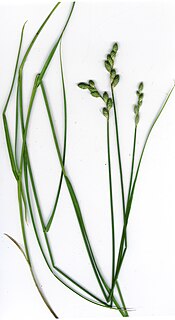
Carex nigra is a perennial species of plants in the family Cyperaceae native to wetlands of Europe, western Asia, northwestern Africa, and eastern North America. Common names include common sedge, black sedge or smooth black sedge. The eastern limit of its range reaches central Siberia, Turkey and probably the Caucasus.

Carex arctata, known as drooping woodland sedge, is a species of sedge native to eastern North America. It is sometimes called black sedge, compressed sedge, or drooping wood sedge. It occurs from Manitoba to the eastern seaboard in Canada, south to northwestern North Carolina, and west to Minnesota. Carex arctata grows in bogs, hardwood forests, and spruce forests.
Carex atrosquama, the lesser blackscale sedge, is a species of sedge that was first formally named by Kenneth Mackenzie in 1912. It is native to the northwestern United States and western Canada, from Alaska south to Utah and Colorado. It grows in alpine and subalpine meadows, as well as along rivers and streams in gravelly areas.

Carex austrina, known as southern sedge, is a species of sedge endemic to the southern and central United States.
Carex bulbostylis, known as the false hair sedge, is a species of sedge native to the southcentral and southeastern United States. It was first formally named by Kenneth Mackenzie in 1915. It is also known as the eastern narrowleaf sedge, thick style sedge, and globose sedge.

Carex cryptolepis, known as northeastern sedge, is a North American species of sedge first described by Kenneth Mackenzie in 1914.

Carex eburnea, known as ivory sedge, ebony sedge, and bristleleaf or bristle-leaved sedge, is a small and slender sedge native to North America, from Alaska and Newfoundland south to central Mexico.
Carex harfordii, or Harford's sedge, is a species of sedge that was first described by Kenneth Mackenzie in 1917. It is native to California.
Carex integra, the smoothbeak sedge, is a species of sedge that was first described by Kenneth Mackenzie in 1917.

Carex longii, or Long's sedge, is a species of sedge found in North America that was first described by Kenneth Mackenzie in 1922.
Carex merritt-fernaldii, or Fernald's sedge, is a species of sedge from northeastern North America. It was first described by Kenneth Mackenzie in 1923. It is named after botanist Merritt Fernald.

Carex normalis, the greater straw sedge, is a species of sedge that was first described by Kenneth Mackenzie in 1919.
Carex projecta, the necklace sedge, is a species of sedge that was first described by Kenneth Mackenzie in 1908.
Carex subbracteata, the smallbract sedge, is a species of sedge that was first described by Kenneth Mackenzie in 1917.
Stiff sedge is a common name for several plants and may refer to:
Smilax biltmoreana, common name Biltmore's carrionflower, is a North American plant species native to the southeastern United States. It is concentrated in the Great Smoky Mountains but with outlying populations in Virginia, North and South Carolina, Tennessee, Kentucky, Georgia, Alabama, and northern Florida.

Carex bebbii, Bebb's sedge, is a species of sedge native to the northern United States and Canada. Carex bebbii grows in a variety of wetland habitats such as lakeshores, streambanks, ditches, meadows, swamps, and seeps. It forms dense tufts with culms up to 90 centimeters tall.

Carex flexuosa, commonly called flexuous white-edge sedge, or Rudge's white-edge sedge, is a species of flowering plant in the sedge family, Cyperaceae. It is native to the eastern North America, where it is found in eastern Canada, the northeastern and midwestern United States, and southward in the Appalachian Mountains. Its natural habitat is in upland forests, rock outcrops, and Appalachian balds. It is typically found in areas with acidic soil.

Carex baileyi is a sedge in section Vesicariae the genus Carex native to the Appalachian mountains in Eastern North America. It is commonly called Bailey's sedge. Carex baileyi was named in honor of Liberty Hyde Bailey by its discoverer, Nathaniel_Lord_Britton.









